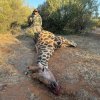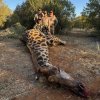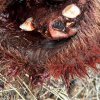- Joined
- Jan 2, 2025
- Messages
- 5
- Reaction score
- 8
- Location
- South Africa
- Website
- elitehuntingoutfitters.com
- Deals & offers
- 1
- Media
- 25
- Articles
- 1
- Member of
- RMEF - SCI
- Hunted
- North America, South Africa
Understanding Giraffe Social Dynamics
In the wild, male giraffes (bulls) follow a strict social hierarchy. Younger bulls often challenge older, dominant males for the right to breed with females in the herd. When a younger, stronger bull takes over, the older male is pushed out, left to live a solitary life. This is a natural process that ensures the survival of the fittest and the passing on of the strongest genes to future generations.
However, older bulls that lose dominance often exhibit aggressive behavior, particularly toward young calves. In an attempt to bring females back into heat, these males may kill the young giraffes in the herd. This behavior, known as infanticide, is common in many species, including lions, primates and many more. In this case, this old giraffe bull had killed five young calves over three years, signaling a major issue with this bulls health and stability.
The Natural Aging Process of Giraffes
Giraffes, like many other herbivores, rely heavily on their teeth to survive. They have a set of permanent teeth that wear down over time due to constant grinding on tough vegetation. Once a giraffe loses its last functional teeth, it can no longer process food effectively, leading to malnutrition and eventually starvation. This can also cause aggressive behavior, towards other animals that stray to close.
In this case, the older giraffe bull had only two teeth left. At over 20 years old, he was reaching the natural end of his life. His declining body condition, evident when compared to healthier individuals, was a clear sign that he was no longer thriving and in fact starting to suffer.
Ethical Hunting as a Conservation Tool
In situations like this, ethical hunting plays a crucial role in wildlife management. Removing older, declining individuals from the population:
• Prevents unnecessary suffering – Instead of allowing the bull to slowly starve to death, a well-placed, humane shot ensures a quick and ethical end.
• Protects younger generations – By removing a bull that was actively killing calves, the herd’s reproductive success improves.
• Makes use of natural resources – Rather than letting the animal’s body go to waste, the meat can provide nourishment for many families and the hide can be used for multiple different things as well.
The Conservation Aspect
Sustainable hunting is a form of wildlife management that benefits both ecosystems and local communities. By carefully selecting which animals are hunted—such as older, non-reproductive, or problematic individuals—populations remain healthy and balanced. Additionally, responsible hunting generates funding for conservation programs, anti-poaching efforts, and habitat protection.
Conclusion
Nature can be harsh, and the balance within animal populations is constantly shifting. Ethical, well-regulated hunting plays a key role in maintaining this balance. In this case, removing an aging giraffe not only prevented further loss of young calves but also ensured that his life contributed to the well-being of local families.
Hunting, when done responsibly, is conservation in action.
In the wild, male giraffes (bulls) follow a strict social hierarchy. Younger bulls often challenge older, dominant males for the right to breed with females in the herd. When a younger, stronger bull takes over, the older male is pushed out, left to live a solitary life. This is a natural process that ensures the survival of the fittest and the passing on of the strongest genes to future generations.
However, older bulls that lose dominance often exhibit aggressive behavior, particularly toward young calves. In an attempt to bring females back into heat, these males may kill the young giraffes in the herd. This behavior, known as infanticide, is common in many species, including lions, primates and many more. In this case, this old giraffe bull had killed five young calves over three years, signaling a major issue with this bulls health and stability.
The Natural Aging Process of Giraffes
Giraffes, like many other herbivores, rely heavily on their teeth to survive. They have a set of permanent teeth that wear down over time due to constant grinding on tough vegetation. Once a giraffe loses its last functional teeth, it can no longer process food effectively, leading to malnutrition and eventually starvation. This can also cause aggressive behavior, towards other animals that stray to close.
In this case, the older giraffe bull had only two teeth left. At over 20 years old, he was reaching the natural end of his life. His declining body condition, evident when compared to healthier individuals, was a clear sign that he was no longer thriving and in fact starting to suffer.
Ethical Hunting as a Conservation Tool
In situations like this, ethical hunting plays a crucial role in wildlife management. Removing older, declining individuals from the population:
• Prevents unnecessary suffering – Instead of allowing the bull to slowly starve to death, a well-placed, humane shot ensures a quick and ethical end.
• Protects younger generations – By removing a bull that was actively killing calves, the herd’s reproductive success improves.
• Makes use of natural resources – Rather than letting the animal’s body go to waste, the meat can provide nourishment for many families and the hide can be used for multiple different things as well.
The Conservation Aspect
Sustainable hunting is a form of wildlife management that benefits both ecosystems and local communities. By carefully selecting which animals are hunted—such as older, non-reproductive, or problematic individuals—populations remain healthy and balanced. Additionally, responsible hunting generates funding for conservation programs, anti-poaching efforts, and habitat protection.
Conclusion
Nature can be harsh, and the balance within animal populations is constantly shifting. Ethical, well-regulated hunting plays a key role in maintaining this balance. In this case, removing an aging giraffe not only prevented further loss of young calves but also ensured that his life contributed to the well-being of local families.
Hunting, when done responsibly, is conservation in action.
Attachments
-
 456661211_122136627374286941_2231126683390927385_n_122136627320286941.JPG585.4 KB · Views: 16
456661211_122136627374286941_2231126683390927385_n_122136627320286941.JPG585.4 KB · Views: 16 -
 456410594_122136627404286941_1896340903236389800_n_122136627338286941.JPG726.8 KB · Views: 14
456410594_122136627404286941_1896340903236389800_n_122136627338286941.JPG726.8 KB · Views: 14 -
 456673850_122136627398286941_978377812129302897_n_122136627356286941.JPG327.2 KB · Views: 13
456673850_122136627398286941_978377812129302897_n_122136627356286941.JPG327.2 KB · Views: 13 -
 456603941_122136627392286941_8599096340250544739_n_122136627344286941.JPG264.6 KB · Views: 14
456603941_122136627392286941_8599096340250544739_n_122136627344286941.JPG264.6 KB · Views: 14